| Columns Retired Columns & Blogs |
Am I incorrect in saying that the woofer appears to behave like a slot-loaded subwoofer with an underdamped resonance peak at 60Hz? Reminds me of the Janus SW10 subwoofer I used to own.

I had my reasons—especially price. The prices of those earlier Estelons were a poor fit for my budget. I was also troubled by the fact that, despite rhetoric about driver and component choice, advanced cabinet materials and construction, and fastidious engineering, Estelon has been stingy with details and specifications—not a complete disqualifier but rather a missed opportunity to appeal to objectivist proclivities.
What changed my mind? First, while Estelon is deservedly known for the elegance of its designs, the AURA is, to me, the cleanest design the company has yet achieved. The black grille tapers from top to bottom in clear counterpoint to the clean, curved white body, which widens top to bottom and seems to levitate just barely off the floor. The effect is unfussy and graceful. Had I been asked my choice of colors, I might have ordered black—the only other color, besides white, that the AURA comes in—but black fails to make the bold fashion statement the white speaker does.
Second, at $19,900/pair, the AURA is much less expensive than those earlier models, including the Forza reviewed by Michael Fremer and the XB Diamond Mk.2 reviewed by Jim Austin (footnote 1). $20,000 is still a lot of money for almost anybody, and any claim that $20,000 is affordable for a pair of speakers would likely be ridiculed by non-audiophiles as well as many audiophiles. Still, it is in range to many more potential buyers than Estelon's other offerings.
Estelon remains stingy with technical information. For example, while they state a frequency range, they do not specify a deviation envelope, plus or minus how many dB. When I asked Estelon for additional data, I learned crossover points (77Hz, woofer–midwoofers; 2.1kHz, midwoofers–tweeter) but not slopes or orders of the crossovers. Still, I was so taken with the design and appearance of the AURA that I went back and read those earlier Estelon reviews. Both offered limited technical specifications, but the speakers were praised by the reviewers (MF and JA2), and both measured well (JA1). That's good enough for me.
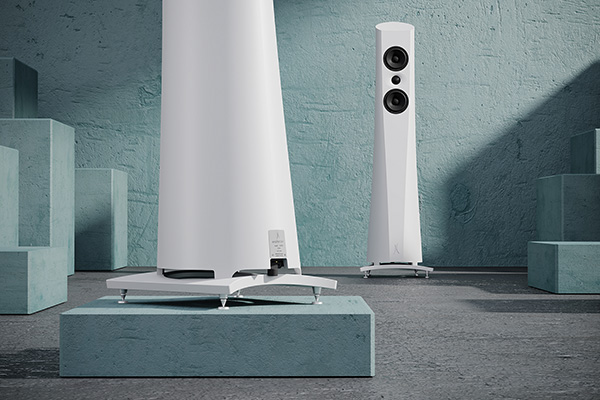
Arrival and setup
The AURAs arrived packed in individual, foam-braced corrugated boxes enclosed by a stronger box with an integrated wood pallet. The test pair came from Estonia, of course, and was "broken in" as a shop demo at a US AURA dealer before being shipped to the local dealer (Stereo Exchange), who delivered and unpacked them. The speakers and packaging were pristine on arrival, attesting to the competence of the packaging design and execution. Included with the speakers were eight adjustable spikes, eight matching floor-protector discs, two pairs of cotton gloves, a polishing cloth, and a user manual.
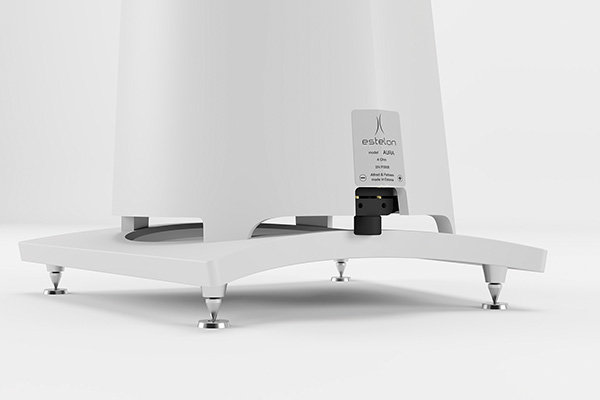
Placed in the usual "sweet spots" at the far corners of the carpet and lifted ever so slightly by the small spikes, the AURAs were eye candy, as expected; their graceful simplicity would suit almost any room. Fit and finish of the proprietary, mineral-filled cabinet and drivers was flawless. The unusual shape and angled top avoid parallel internal surfaces. With the grille in place, the only notable exterior features are the gently arched base plate, which is separated from the main cabinet by a 2cm gap to allow for the output of the downward facing 10" woofer and the speaker terminals, which are almost hidden under the bottom rear of the main cabinet. The AURAs' appearance benefits from the accent provided by the grille, and I am pleased to say that I preferred to listen to them with the grilles in place. If that is a consequence of a visual bias, so be it.
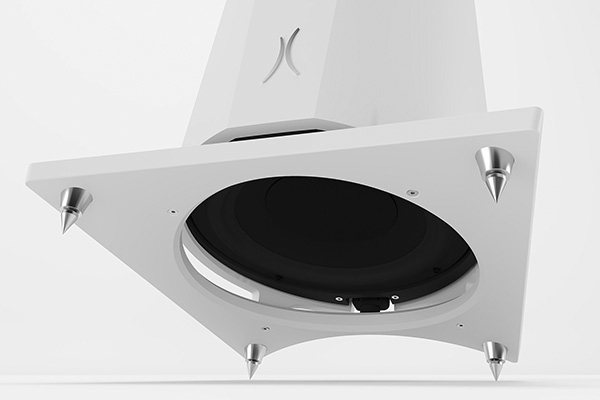
With the grille removed, one sees a vertical M-T-M arrangement, the 1" Scan-Speak tweeter flanked by a pair of 5" midwoofers near the top of the speaker. The crossover between the tweeter and the midwoofers is at 2.1kHz; the tight spacing results in a midwoofer-midwoofer spacing of about a wavelength at that frequency, the tweeter-midwoofer spacing half that. Such an arrangement could cause beaming interference, but in a vertical array, it would only be an issue above or below a normal seated position.
Estelon calls these drivers midwoofers not midrange drivers because their range extends down to a low 77Hz, where the down-facing woofer begins to take over. The center of the M-T-M trio is about a meter above the woofer, a small fraction of a wavelength (approximately 4.5 meters) at the crossover, so there should be no issues there. Estelon emphasizes the care lavished on said crossover, which utilizes:
• Mundorf Supreme and Classic resistors
• Mundorf air-core coils (inductors) for midwoofers and tweeter
• Mundorf resin-impregnated coils for bass
• Kubala-Sosna internal wiring.
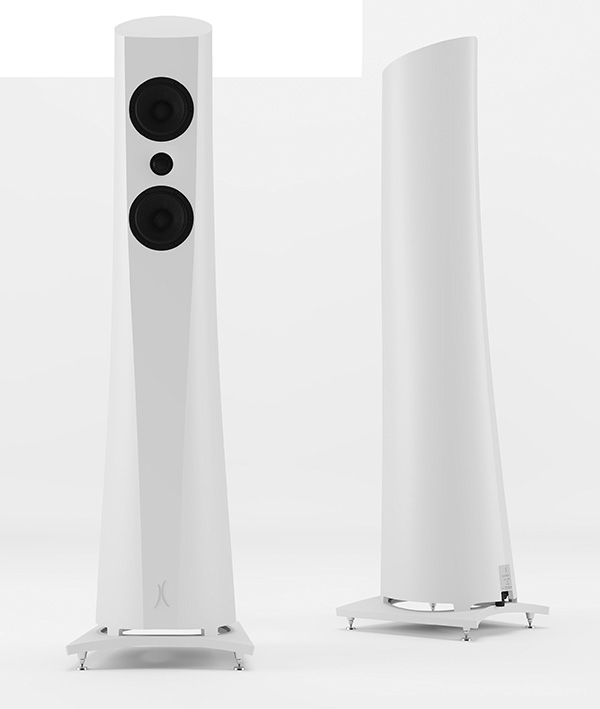
I connected the AURAs to a single NAD C 298 stereo amplifier, and later to a pair of monoblock Benchmark AHB2 amplifiers, via spade-terminated AudioQuest Granite cables; the AURA terminals also accept banana-plug terminations. My experiments with placement ended up with the speakers about 7.5' apart, 5' from the front wall, and about 3' from the sidewalls. They were toed in just a little, close to the factory-recommended 7°.
Hello, beautiful
From the first notes—well before I finalized position and toe-in—I found that the AURAs' beauty was not superficial. They sounded open and detailed and, once properly placed, well-balanced. I like to use solo piano recordings to start a review because the piano is a single acoustical instrument with wide ranges in frequency and dynamics. The challenge for any component, including the AURAs, is to convey all the notes, singly and in chords, with presence, tonal balance, and clarity while also making clear that the source of all that sound is a single large instrument in a real acoustic space.
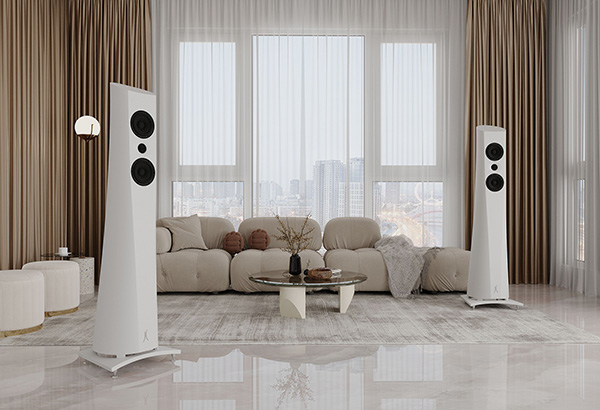
The AURAs achieved all that with a pair of new recordings of Liszt's Transcendental Etudes performed by Francesco Piemontesi (Pentatone 5187052) and by Haochen Zhang (BIS-2681). Both play Steinways, and both recordings were auditioned via 24/96 FLAC files downloaded from the labels' websites. The instruments and their aural environments are remarkably similar to each other, but I detect a bit more focus in the BIS recording. And, although Zhang was recorded in a film/recording studio in Munich and Piemontesi in a small, modern concert hall in Lugano, neither recording offered much information about the acoustics of the recording sites. The contrast is in the playing. Zhang clearly relishes articulating individual notes, which he does with almost superhuman precision. Piemontesi leans toward a more legato expression, although the Estelons still let me hear each of the notes when I attended to them. Zhang's delineations were thrilling in the "big" pieces, such as No.4, "Mazeppa," and No.8, "Wilde Jagd," but also surprisingly touching in the more delicate No.7, "Vision"; he kept me hanging on every note, with bated breath. Strangely, Piemontesi's more fluid playing achieved more momentum in the big pieces and provided a much-appreciated grace in the delicate pieces. I listened to both performances several times via the AURAs. The experience was informative, enjoyable, and totally nonfatiguing.

I recently came upon a recording of chamber wind pieces by György Ligeti—a new release from Harmonia Mundi (CD, HMM905370) recorded in 2016 and remastered and reissued only this year. The earlier issue (Musicales Actes Sud ASM 26) was criticized for its sound quality, but Harmonia Mundi's 2023 release, which I downloaded in 24/96 FLAC, is spectacular. Via the AURAs, the instruments in the opening Six Bagatelles for Wind Quintet popped like a poster-painted posy, each clearly delineated, richly colored, and arrayed on a soundstage that extends laterally beyond the speakers. The closest wind instruments sounded as close as the speakers, the ensemble extending to a few feet behind, and there was a strong illusion of performers in my room. Quite thrilling, of course, but I missed any sense of the recording-site acoustics. Fortuitously, the major work on this recording, Ligeti's Chamber Concerto, with François-Xavier Roth conducting Les Siècles, a larger ensemble, was recorded in a larger space, which endows the ensemble's sound with a richer ambience (footnote 2). This was appreciated, especially when the AURAs' low-frequency performance delivered tight and detailed bass. In the motoric third movement, the pacing and percussion simulate synthetic music; it is reproduced here with surgical precision. The fourth movement is mellow and flowing save for one manic outburst; I was engrossed throughout by the music as the AURAs conjured a vivid illusion of a live performance.
Footnote 2: The album notes identify both recording sites, the Méjan Chapel in Arles and the Cité de la musique in Soissons, but do not associate individual works with the sites. From the pictures I see on the internet and from what I hear, I suspect that the Concerto was recorded in Soissons and the two pieces for quintet in Arles.

Am I incorrect in saying that the woofer appears to behave like a slot-loaded subwoofer with an underdamped resonance peak at 60Hz? Reminds me of the Janus SW10 subwoofer I used to own.


Kal and John,
Thank you both again for another interesting review, measurements, analysis and assessment, all of it.
Something that remains a little unclear to me is in the details of the moving dolly utilized during the measurements. Was it utilized in the nearfield measurements of the woofer? If so, was the top surface of the dolly providing a flat continuous non-leaky boundary, extending well beyond the perimiter of the loudspeaker's plinth, providing good simulation of the floor?
I ask because loudspeaker's plinth has a large hole through the center, with the plinth providing venting geometry, and with the floor serving as the lower boundary in that semi-enclosed vented air cavity below the woofer. So, raising the loudspeaker onto a moving dolly of a type with an open top framework would increase the volume of that semi-enclosed air cavity and would greatly increase venting in the region of the dolly casters. A leaky top dolly (spaced decking) would change the venting. If the dolly did not have a continuous flat surface extending well beyond the perimeter of the plinth, then that would affect venting. Any of those changes in the woofer loading and alignment would have some significant effects in the electro-acoustic response of the woofer. However, if the dolly had a flat, continuous, air-tight top extending well beyond the perimeter of the plinth, then I would expect its use would not have any significant effects in the nearfield measurements of the woofer relative to measuring same with the loudspeaker placed on the floor.


While some of the engineering appears decent, the absurdly low impedance and laughably bad woofer alignment are complete deal breakers. I'm surprised Kal liked these as much as he did.